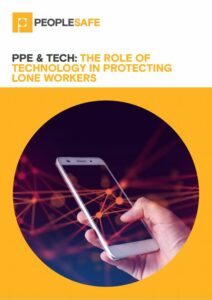The changing face of today’s workforce: The role of tech in supporting employee wellbeing
From technology developments to changes in the workplace, lone worker protection has evolved considerably over recent years.

COVID-19 has placed into question the traditional duty of care that employers have for their employees: from remote workforces and socially distanced team members, to hybrid working arrangements and a shift from the 9-5 commute, organisations are reviewing how they ensure the health, safety and wellbeing of employees during working hours and beyond.
Peoplesafe recently worked with over 120 health & safety professionals to understand how technology is playing a role in supporting employee wellbeing, from personal safety to enhancing communications, and published its findings within its whitepaper, “PPE & Tech: The role of technology in protecting lone workers”. The paper includes perspectives from a range of sectors, including quotes from senior health and safety professionals across the NHS, Virgin Media, Royal Mail and others which were obtained during a round table that was run with SHP. It goes into detail on how they navigated COVID-19 and where technology had a key role in keeping all personnel safe.
It also looks at how duty of care is extending beyond the working day; considering the wellbeing of home workers and those employees commuting during unsocial hours, going on to consider how firms provide support and peace of mind to workers travelling to and from work, from shift workers to lone workers – particularly following the HSE’s updated guidance on lone workers, recommending firms “implement a robust system to ensure a lone worker has returned to their base or home once their work is completed”.
“The impact of the COVID-19 pandemic has accelerated technology adoption across every aspect of the sector: a McKinsey study concluded that ‘companies have accelerated the digitisation of their…internal operations by three to four years,”, said Naz Dossa, CEO at Peoplesafe.
“The number of lone workers has risen over the last 12 months, from enforced remote working to more vulnerable lone workers now operating in isolation or out of earshot under social distancing measures far more frequently. As more firms announce plans to roll out flexible and hybrid working and cement temporary changes into permanent practices, it is clear that the working environment is changed forever.
“This also has its downsides: teams are more disparate and new working practices have created new or heightened challenges, from managing increased risk and vulnerabilities to wellbeing concerns. So what does that mean for lone worker protection.
“This report from Peoplesafe explores how firms have adapted to these changes and provides a useful view of how firms plan to continue their technological transition. Lone worker technology, integrated well into organisations’ systems and processes, can now provide firms with a smarter and more cost-effective way to meet their duty of care and protect and communicate with at-risk employees.
“We predict that technology will increasingly become part of an employee’s essential toolkit, marking a shift from PPE to PPET: Personal Protective Equipment and Technology to prevent, manage and respond to risks in the workplace.”
The report was produced off the back of a roundtable, hosted by SHP. Click here to listen to clips from the session on a recent episode of the Safety & health Podcast.
Contents:
- COVID-19 and the evolution of health & safety
- The impact of COVID-19 on lone working
- Responding to new risks
- The new ways of working
- Future use of technology
- Connected technology
- Data-driven decisions
- Embedding technology into company culture
- Including tech in PPE
- Lone worker regulations
- Adoption and engagement
If you’re interested in learning more, simply fill out the form to receive your whitepaper.
Sponsored by:

PPE and tech: The role of technology in protecting lone workers
From technology developments to changes in the workplace, lone worker protection has evolved considerably over recent years.
Safety & Health Practitioner
SHP - Health and Safety News, Legislation, PPE, CPD and Resources 

